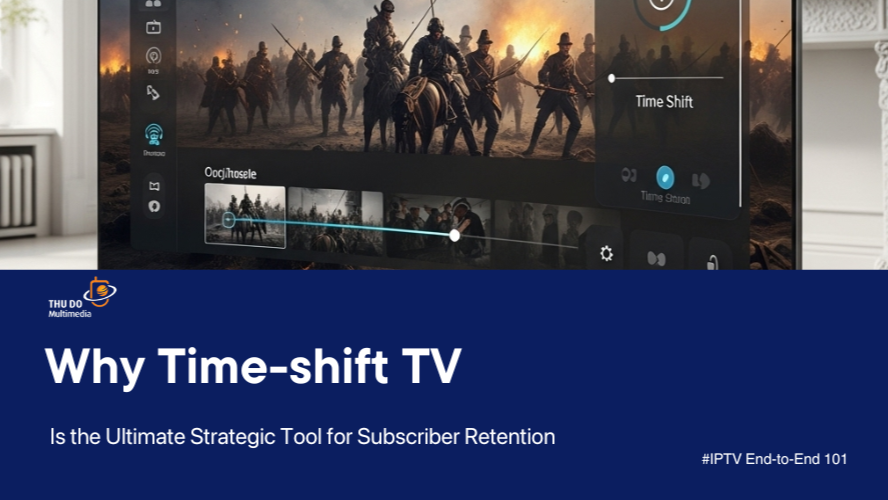Explore why Time-shift TV has emerged as a powerful retention tool for Pay TV and IPTV providers. Flexibility, personalization, and lower churn – all in one strategic feature.
What Is Time-shift TV and Why It Matters in IPTV End-to-End Platforms
As the competition heats up in the pay-TV and IPTV market, retaining subscribers has become a mission-critical priority for service providers. Today’s viewers are no longer satisfied with traditional TV models, which bind them to rigid broadcast schedules and fixed time slots. They crave flexibility, control, and a viewing experience tailored to their needs. This is precisely why Time-shift TV is gaining momentum as a strategic “strategic tool” for broadcasters, telcos, and IPTV platforms to maintain subscriber loyalty, reduce churn, and maximize customer lifetime value.
What Is Time-shift TV and Why Does It Matter?
At its core, Time-shift TV is a feature that allows viewers to “shift time”-meaning they don’t have to be in front of the screen at the exact moment of broadcast. Instead, they can replay their favorite content anytime within a predefined window (such as 24, 48 hours, or even up to a week). This function gives IPTV subscribers the freedom to pause, rewind, or replay live shows without missing key moments. Unlike traditional Video-on-Demand (VOD), which only offers pre-stored content, Time-shift TV retains the live experience with added flexibility-perfect for today’s fast-moving, mobile-first audiences.
Why Time-shift TV in IPTV End-to-End Solutions Boosts Retention
One of the biggest advantages of Time-shift TV is its ability to prolong viewer engagement with the platform. When subscribers realize they don’t have to rush to catch a football match, a game show, or a news broadcast, they feel less pressure-and become more willing to commit to long-term plans. This mindset creates an invisible barrier against churn-a critical metric every IPTV or Pay TV operator must monitor closely. Moreover, users often share this convenience with family and friends, which organically expands reach and attracts new customers through loyal user networks.
Optimizing Cost and Infrastructure Through Time-shift TV
Another noteworthy benefit is on the cost and infrastructure optimization side. Instead of investing heavily in massive VOD libraries-which demand significant storage and bandwidth-broadcasters can temporarily buffer live streams within a reasonable time window. This significantly reduces infrastructure costs compared to producing or acquiring complete VOD catalogs. At the same time, Time-shift TV unlocks new upsell opportunities: subscribers can be offered premium plans that extend playback windows, enable multi-channel rewind, or store shows for longer periods-all contributing to ARPU growth.
Serving the Modern Viewer With More Flexibility
Consumer behavior research shows that even in the booming IPTV era, linear live TV still holds a unique appeal, thanks to its real-time and communal nature. However, the rigid scheduling model is its Achilles’ heel. Time-shift TV bridges the gap-preserving the urgency and relevance of live broadcasts while supporting on-demand viewing habits. This is especially critical for younger audiences, busy professionals, and the elderly-user segments more likely to cancel when they miss their favorite content. Without Time-shift TV, providers risk losing these viewers for good or facing high marketing costs to win them back.
Global Trends: Time-shift TV Adoption in IPTV End-to-End Platforms
In many advanced markets like Europe, the U.S., and South Korea, Time-shift TV has long been deployed and proven effective at maintaining subscriber bases. Leading broadcasters even combine Time-shift TV with personalization technologies-like content recommendations or favorite schedule bookmarks-to enhance the user experience. Many local IPTV platforms have quickly followed suit, especially as they face off against global giants like Netflix, Disney+, and Amazon Prime Video. While these platforms dominate with massive VOD libraries, local providers have the upper hand in delivering localized live content enhanced with Time-shift features.
Technical Considerations: Deploying Time-shift TV in End-to-End IPTV Systems
To deploy Time-shift TV effectively, technology alone isn’t enough. Providers must also ensure stable network infrastructure, multi-CDN delivery capabilities, and robust content protection through DRM. The ability to rewind, store, or replay content comes with legal and security risks-including piracy and unauthorized sharing. As a result, many providers are combining Time-shift TV with Digital Rights Management (DRM), watermarking, and fingerprinting solutions to meet both compliance and content owner requirements.
Time-shift TV: A More Efficient Investment Than Subscriber Acquisition
From a business perspective, Time-shift TV is a more cost-effective investment compared to the expense of acquiring new subscribers. In many cases, the cost of deploying Time-shift features is significantly lower than marketing campaigns, promotional discounts, or win-back strategies. A long-term, low-churn subscriber offers greater revenue stability than constantly chasing new signups without solid retention strategies. That’s why Time-shift TV is consistently featured among the “must-have” capabilities in IPTV platform roadmaps and investment proposals.
The Future of Time-shift TV: Personalization, Data, and Monetization
Looking ahead, Time-shift TV is poised to evolve beyond simple replay functionality. With advancements in AI, Big Data, and behavioral analytics, TV platforms can build predictive recommendation engines, automate alerts for upcoming content, and personalize viewing timelines. This opens new frontiers in data monetization, targeted advertising, and infrastructure efficiency – all while offering unique viewing experiences for every subscriber.
In a market where every platform is fighting to retain viewer loyalty, Time-shift TV is no longer just a nice-to-have – it’s a competitive necessity. It satisfies the modern viewer’s demand for flexibility, helps providers optimize cost, reduces churn, and supports scalable business growth. Those who adopt and refine Time-shift TV now will be better positioned to retain customer loyalty – and lead in a market defined by convenience and personalization.
Zooming out, Time-shift TV is just one part of a premium feature ecosystem being deployed by modern broadcasters to retain users. Alongside Time-shift, features like Catch-up TV, Start Over, and EPG (Electronic Program Guide) are fast becoming the new standard to meet modern viewer expectations. In India, premium services like Jio and Sony LIV are aggressively rolling out these capabilities to strengthen service value, boost retention, and capture a larger OTT/IPTV market share.
With deep expertise in IPTV end-to-end solutions, Thu Do Multimedia is ready to equip Indian ISPs and broadcasters with cutting-edge features such as Time-shift TV, Catch-up TV, Start Over, EPG, and more – cost-optimized, fast to deploy, and tailored for real-world operations.
So, who is Time-shift TV really for? It’s not just a technical feature, it’s a strategic retention asset for every player navigating the shifting demands of digital TV:
- IPTV and Pay TV providers looking to fight churn and build loyalty
- Regional broadcasters aiming to modernize without massive VOD costs
- ISPs entering the OTT/IPTV space and needing value-added features
- Telcos seeking scalable, flexible content delivery that users love
In a content economy where convenience and personalization are non-negotiable, Time-shift TV, when deployed as part of a robust IPTV End-to-End platform, is no longer optional. It’s a key building block for a scalable, flexible, and future-proof media business.
For more on how IPTV End-to-End solutions help providers like yours win in competitive markets, check out our related post: Why Are Small ISPs Under So Much Pressure? How IPTV End-to-End Can Transform Their Future
Interested in finding the right IPTV End-to-End solution for your TV system? Contact us today to explore how we can support your deployment strategy.


Recent Comments